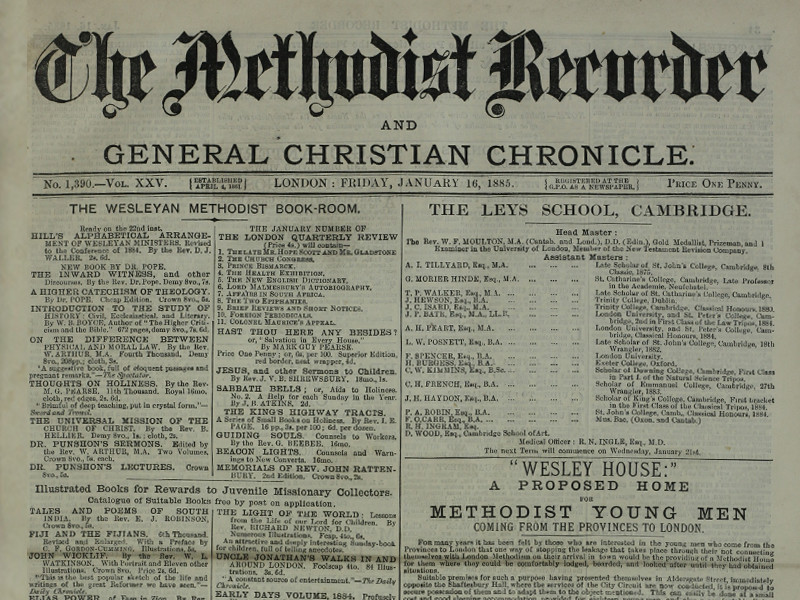
The Methodist Recorder, 1861–1919

Items from the Oxford Centre for Methodism and Church History
Although never an actual Methodist publication, the 'Recorder' became in many ways considered to be the denomination’s official mouthpiece, both by its readers and the church, but also to some extent its staff—who at times needed to assert their independence.Oxford Brookes University
Access the full collection
Access the full archive of The Methodist Recorder, 1861–1919.
Institutional Free Trial
Start your free trialRegister for a free 30-day trial of The Methodist Recorder, 1861–1919, for your institution.
Institutional Sales
Visit Sales PagesellFor more information on institutional access, visit our sales page.
Single User License
Purchase a license below to view the full collection.
Already have a license? Sign in.
Study the development of 19th and 20th century Methodism through print journalism

This collection contains copies of the Methodist Recorder published during the period 1861-1919. Founded in 1861 with the mission 'to tell truth and love', the Methodist Recorder was edited and published by six Wesleyan ministers in London. While the six ministers responsible for creating the Recorder formed an ‘editorial council’, editorial control initially rested largely with Reverend William Morley Punshon, an influential minister in a prominent London circuit. The ministers were followers of John Wesley (1703-1791), an English cleric who led a revival movement within the Church of England known as Methodism.
Created as an independent weekly newspaper that scrutinised current affairs within the Methodist community, the Recorder was widely successful and has been published continuously for more than 150 years. The Recorder emerged as a more liberal rival to the first Methodist newspaper, The Watchman, which it later incorporated. Subjects covered were wide-ranging, from current events to the promotion of worthy charities and literary recommendations.
Contents
The Methodist Recorder, 1861–1919...
Items from the Oxford Centre for Methodism and Church History
Discover
Highlights
Insights
- Support for the poor, sick, and infirm is one of the vital pillars of Methodist teaching. Throughout this collection, large illustrated pages encourage readers to give to charitable causes, including hospitals, orphanages, soup kitchens, and schools.
- The 19th century saw a significant expansion of the printed word. Technological developments and higher literacy rates contributed to the growth of Methodism through print culture.
- Methodism encouraged total abstinence from alcohol. Strong support for the temperance movement is evident throughout this collection, not only through lectures and sermons, but also advertisements for non-alcoholic wine, Bovril, and Cadburys cocoa.
- 'The Methodist Recorder' was a Wesleyan publication. Also prominent in England at the time were the Primitive Methodists, who were characterised by their plain chapels and a poorer social base compared to their more middle-class Wesleyan counterparts.
- The document for the year 1891 features the illustrated Wesleyan Centenary Number, commemorating a hundred years since the death of John Wesley. This issue examines Wesley’s life and achievements.
- 'The Methodist Recorder' is still in print today.
Unlock Historical Research for Your Institution
Provide your students and researchers with direct access to unique primary sources.
Related Media







.svg)



